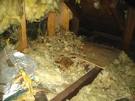|
|
 |
Check With Your Agent Your
Wildlife Damage MAY BE COVERED Under Your "Home Owner's
Policy"
Some Insurance
Companies may cover Bat Exclusin, since they (Bats) are not rodents. Most homeowners policies will not cover any rodent damage or removal, but since bats are not rodents, contacting your agent prior to an exclusion is suggested. Oddly
enough, we have found many insurance companies will not cover the exclusion cost, but will cover the guano removal and clean-up
program. The good news is, insurance companies will often pay for some, if not all, of the costs
incurred to get rid of bats. Also, damage incurred by raccoons or other wildlife may be covered, again
contacting your agent prior to an exclusion and repair is suggested.
If
needed, we will provide a detailed estimate for your Agent.

Many people in Ohio live
with problems that they do not realize are potentially dangerous. People have ignored bat colonies, squirrels in the wall
even raccoons in the chimney because they do not understand the potential health risks to themselves or their family Often
people are under the impression that they cannot do anything about wild animals, because they are protected, well the truth
is that all wildlife are protected in one form or another But then again so are people. People are also under the impression
that their taxes should cover wildlife issue’s and try to depend on the local fire department or Animal Control Officers.
As with any job description the removal of wildlife takes professional training and specific insurance requirements and municipal
employee’s are not covered to be working on or performing services on private property, and are specifically prohibited
by law from referring private sector work to themselves or each other.
THEREFORE
PROPER EXCLUSION AND RESTORATIONS (Removal of Affected Items and Sanitization) OF AN AREA IS A MUST WHETHER COVERED BY INSURANCE
OR NOT.
|
 |
|
People
know who to call when they see ants, cockroaches and termites crawling around, but many of these pest control professionals
are not trained in wildlife damage management. The same maybe true of animal control officers, fire, police and others engaged
in public safety professions. Wildlife control is best left to a professional. For their own safety,
homeowners should not try to confront unwanted wildlife or attempt off-label use of household products, which is dangerous
and may be illegal.
Ohio’s
general law gives property owners the right to use lawful means to destroy wildlife in the act of causing damage or threatening
personal safety. The public may only address wildlife actually causing damage or posing immediate threats and may not randomly destroy wildlife as a preventive measure.
|
 |
|
|
|
 |
The impact of wildlife damage
is enormous, but the public is largely unaware of this threat. The economic damage from all forms of wildlife damage is conservatively
estimated to be about $22 billion – and that does not include illness and death resulting from interaction with dangerous
wildlife. Animals like bats, raccoons, geese, mice, squirrels, beaver, skunks and other wildlife pose a potentially serious
threat to personal property and public health. For example, bats are vectors of the rabies virus, which is deadly to humans,
and feces from raccoons carry thousands of roundworm eggs that can be a serious health hazard.
|
 |
|
|
|
|
|
|
|
 |

